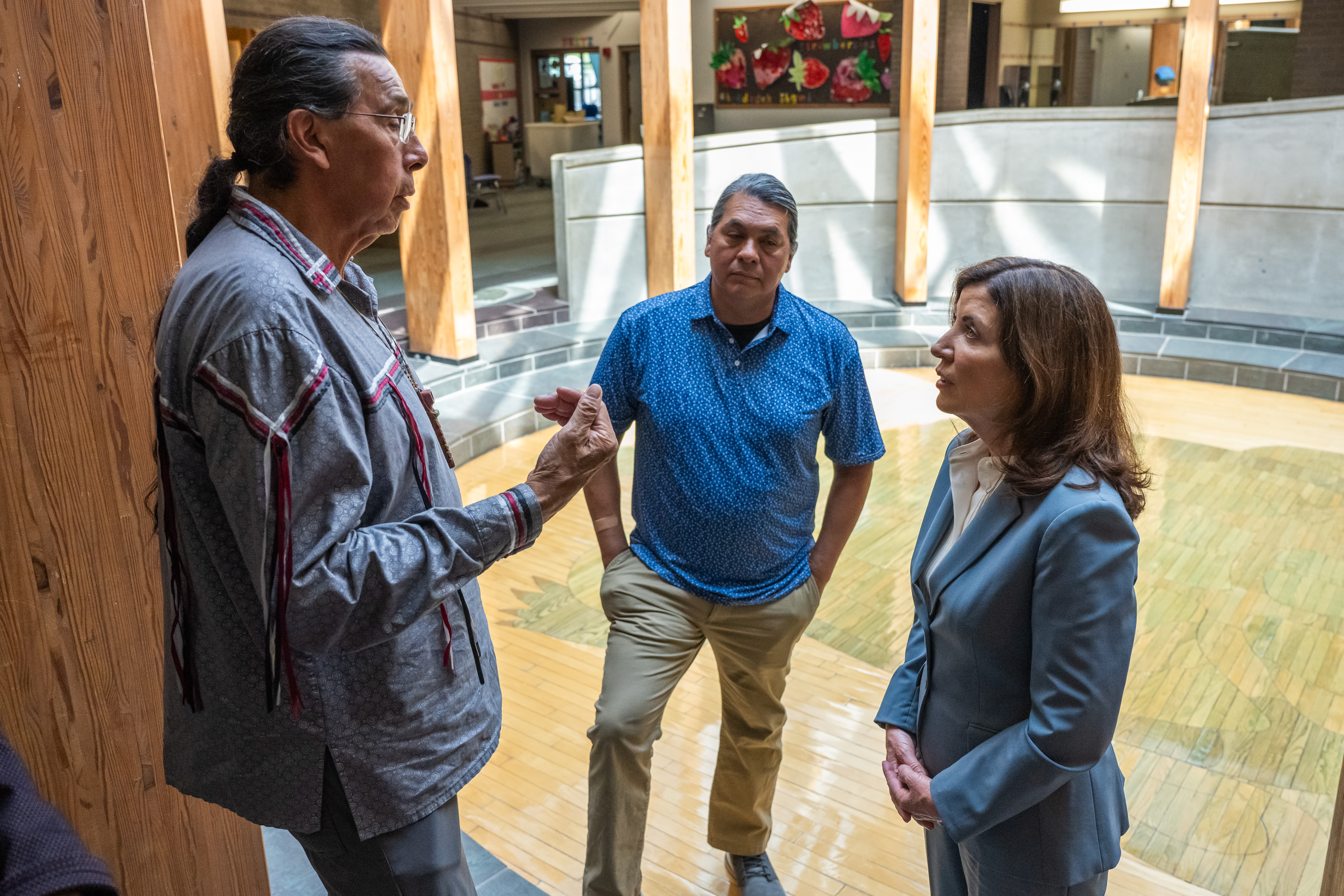
- Details
- By Native News Online Staff
Wednesday was a historic day on the Onondaga Nation as Tadodaho (Chief) Sid Hill greeted New York Governor Kathy Hochul (D) to the homelands of the Onondaga Nation for discussions to improve relations between his tribal nation and the State of New York. It was the first visit to the Onondaga Nation by a governor of the Empire state in over 50 years.
Hill was joined by representatives from the Council of Chiefs and Clan Mothers in the Onondaga Nation Longhouse.
“We extend our gratitude in hosting Governor Hochul, an occurrence that marks the first visit by a Governor of New York to our Longhouse in no less than five decades. Anticipating collaboration with both her and State officials, our focus rests on securing the educational and healthcare support that our treaties guarantee for our community members,” Tadodaho Hill said.
 Make A Donation Here
Make A Donation Here
Gov. Hochul called the visit a significant step in strengthening the relationship between the Onondaga Nation and the State of New York.
“This meeting follows the momentous event of returning over 1,000 acres of land to the Onondaga Nation. During our constructive and profound conversations, we delved into the distinct challenges that the Onondaga Nation faces,” Gov. Hochul said. Moreover, we explored avenues through which our two administrations can collaborate, notably in the realms of education and healthcare. Our pledge involves sustaining an ongoing discourse regarding these pivotal matters and fostering a respectful partnership in the years that lie ahead."
Gov. Hochul was referring to the land return in June 2022 which was one of the largest transfers from a state to an Indigenous nation—was part of a 2018 Natural Resource Damage Assessment and Restoration settlement. The settlement is an agreement between the Dept. of the Interior’s trustees U.S. Fish and Wildlife Service and New York State Department of Environmental Conservation, and the landowner, Honeywell International Inc., to transfer the land title back to the Onondaga Nation.
“Constructive dialogue serves as the cornerstone of amicable government-to-government interactions. We concur that the restitution of 1,000 acres at the origins of Onondaga Creek stands as a long-delayed acknowledgment of the imperative to reverse the environmental deterioration of the land and waters that have nurtured our people since well before the arrival of European settlers,” Tadodaho Hill said.
“We hope this juncture signals the inception of an enduring and fruitful dialogue geared toward reinstating harmony and equity on our ancestral territories. The Onondaga Nation aspires for this meeting to accelerate the course of truth and healing between our two governance bodies, as we labor collectively toward enduring justice, serenity, and consideration for all who inhabit this region—the very homeland of the Onondaga Nation and its populace.” Tadodaho Hill continued.
More Stories Like This
Native News Weekly (August 25, 2024): D.C. BriefsUS Presidents in Their Own Words Concerning American Indians
Indigenous Actor Elaine Miles Reports Detention by Alleged ICE Agents
Happy Thanksgiving from Native News Online
Coming Up on Native Bidaské: Behind the Animation: Joey Clift Talks “Pow” and Native Storytelling
Help us tell the stories that could save Native languages and food traditions
At a critical moment for Indian Country, Native News Online is embarking on our most ambitious reporting project yet: "Cultivating Culture," a three-year investigation into two forces shaping Native community survival—food sovereignty and language revitalization.
The devastating impact of COVID-19 accelerated the loss of Native elders and with them, irreplaceable cultural knowledge. Yet across tribal communities, innovative leaders are fighting back, reclaiming traditional food systems and breathing new life into Native languages. These aren't just cultural preservation efforts—they're powerful pathways to community health, healing, and resilience.
Our dedicated reporting team will spend three years documenting these stories through on-the-ground reporting in 18 tribal communities, producing over 200 in-depth stories, 18 podcast episodes, and multimedia content that amplifies Indigenous voices. We'll show policymakers, funders, and allies how cultural restoration directly impacts physical and mental wellness while celebrating successful models of sovereignty and self-determination.
This isn't corporate media parachuting into Indian Country for a quick story. This is sustained, relationship-based journalism by Native reporters who understand these communities. It's "Warrior Journalism"—fearless reporting that serves the 5.5 million readers who depend on us for news that mainstream media often ignores.
We need your help right now. While we've secured partial funding, we're still $450,000 short of our three-year budget. Our immediate goal is $25,000 this month to keep this critical work moving forward—funding reporter salaries, travel to remote communities, photography, and the deep reporting these stories deserve.
Every dollar directly supports Indigenous journalists telling Indigenous stories. Whether it's $5 or $50, your contribution ensures these vital narratives of resilience, innovation, and hope don't disappear into silence.
 The stakes couldn't be higher. Native languages are being lost at an alarming rate. Food insecurity plagues many tribal communities. But solutions are emerging, and these stories need to be told.
The stakes couldn't be higher. Native languages are being lost at an alarming rate. Food insecurity plagues many tribal communities. But solutions are emerging, and these stories need to be told.
Support independent Native journalism. Fund the stories that matter.
Levi Rickert (Potawatomi), Editor & Publisher

